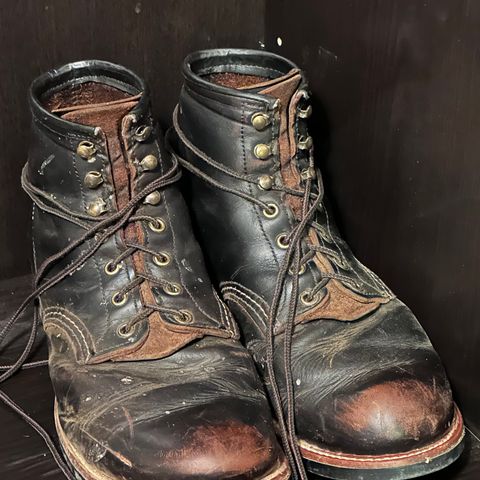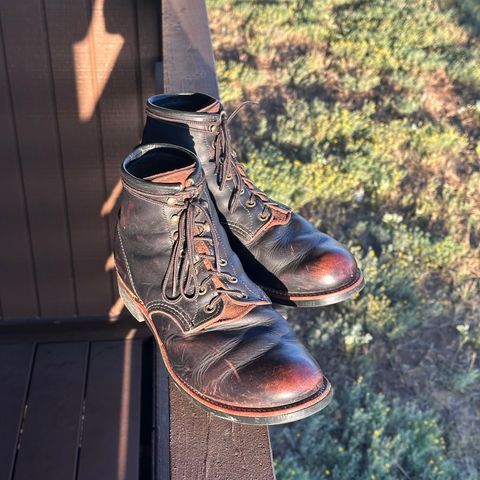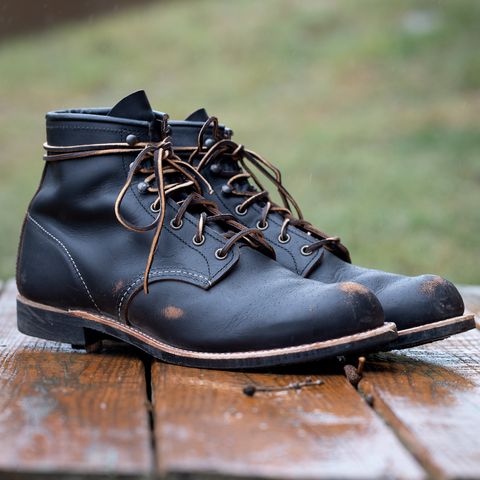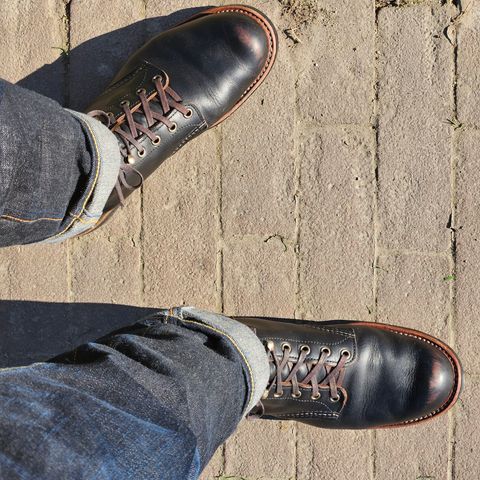About
S.B. Foot Black Prairie is a teacore leather construction that applies a black finish over Prairie's brown base crust, creating a distinctive two-tone aging effect. Produced by S.B. Foot Tanning Company in Red Wing, Minnesota, Black Prairie combines the full-grain oil-tanned characteristics of Prairie leather with a black surface coating that gradually wears away through use. As the footwear flexes and ages, the black finish reveals brown tones underneath at high-wear areas including vamp creases, heel counters, and toe boxes, while less-stressed surfaces retain their black coloring longer. This creates individualized patina patterns that reflect the wearer's gait and usage, making each pair of boots unique.
About
S.B. Foot Black Prairie is a teacore leather construction that applies a black finish over Prairie's brown base crust, creating a distinctive two-tone aging effect. Produced by S.B. Foot Tanning Company in Red Wing, Minnesota, Black Prairie combines the full-grain oil-tanned characteristics of Prairie leather with a black surface coating that gradually wears away through use. As the footwear flexes and ages, the black finish reveals brown tones underneath at high-wear areas including vamp creases, heel counters, and toe boxes, while less-stressed surfaces retain their black coloring longer. This creates individualized patina patterns that reflect the wearer's gait and usage, making each pair of boots unique.
The teacore construction appeals particularly to heritage footwear enthusiasts who value visible aging and distinctive character development. Unlike solid-dyed black leathers that remain uniformly dark throughout their thickness, Black Prairie's layered color structure evolves over months and years of wear. Scuffs and scratches immediately expose the brown base beneath the black finish, creating natural distressing that integrates into the overall patina. Black Prairie maintains the same oil-tanned performance characteristics as natural Prairie, including water resistance, supple hand feel, and the distinctive "pull up" effect where the leather momentarily lightens when bent or stretched as oils shift within the leather structure.
Construction and Characteristics
Black Prairie is built on Prairie's neutral crust foundation, utilizing the same wet stuffed retanning process that defines the leather type. The brown base crust receives S.B. Foot's traditional oil and wax treatment during drum processing, where steerhides soak in specialty tree oils and tanning agents for 14 to 20 hours. This wet stuffed retanning technique saturates oils and conditioning compounds throughout the leather thickness while the hide remains in a wet, receptive state, providing the durability and water resistance characteristic of oil-tanned leather.
The black finish is applied over this prepared brown base crust, creating the teacore structure. This black surface coating provides a formal appearance when new while setting up the distinctive aging trajectory that distinguishes Black Prairie from other black leathers. The finish adheres to the oil-treated surface but is designed to wear away gradually through natural use, rather than remaining permanently fixed like solid-dyed black leather.
The full-grain construction retains the complete natural grain surface without correction or buffing, preserving the leather's inherent character and structural integrity. Natural beauty marks including small scars, brands, and grain variations present in the original hide remain visible and become more pronounced as the leather ages. The heavyweight construction and oil content provide the same durability and flexibility as natural Prairie, making Black Prairie suitable for demanding work boot applications while maintaining footwear comfort.
The oil and wax combination creates the "pull up" characteristic where the leather visibly lightens when bent or stretched. At flex points, the black finish momentarily reveals lighter tones as the oils shift within the leather structure. Once tension releases, the oils redistribute and the color darkens again. This dynamic visual effect demonstrates the oils' continued presence throughout the leather's life and adds to Black Prairie's distinctive appearance.
Teacore Aging Process
The teacore effect develops progressively through natural wear and environmental exposure, creating character that reflects individual use patterns. The black finish wears away most rapidly at areas experiencing repeated flexing and abrasion. Vamp creases—the natural flex points across the toe box—show brown breakthrough first, as constant walking motion stresses the finish at these locations. Heel counters develop brown tones as the boot moves against the ankle during each step. Toe boxes reveal brown base where contact with surfaces causes gradual finish removal.
Less-stressed surfaces including the shaft quarters and tongue maintain black coloring significantly longer, creating natural contrast between high-wear and low-wear areas. This selective aging produces the characteristic two-tone appearance that makes teacore leathers visually distinctive. The transition occurs gradually rather than suddenly, with brown tones emerging incrementally over weeks and months of regular use.
Scuffs and scratches immediately reveal the brown base beneath the black finish, creating instant visual feedback from impacts and contact. Heritage footwear enthusiasts generally consider this instant color revelation desirable rather than damage, as it demonstrates the leather's authentic construction and adds to the overall character. Each scuff becomes a permanent mark that contributes to the boot's individual history.
The brown base becomes increasingly visible over extended wear, with the leather eventually developing reddish-brown tones that contrast dramatically with remaining black areas. After several months to a year of regular use, Black Prairie boots typically display extensive brown breakthrough at all major flex points while retaining black coloring on flatter surfaces. After multiple years of wear, the black finish may remain only in protected areas, with the majority of visible surfaces showing the brown base crust.
The rate of color breakthrough varies based on wear frequency, environmental conditions, and individual gait patterns. Wearers who walk extensively or whose gait creates pronounced vamp creases will see faster brown emergence than those with light use patterns. Exposure to moisture, salt, and abrasive surfaces accelerates finish wear, while primarily indoor use with minimal environmental stress preserves black coloring longer.
Applications in Footwear
Black Prairie finds primary application in Red Wing Heritage footwear, where its distinctive aging characteristics align with the brand's emphasis on authentic patina development and long-term character. The Classic Moc style 8849 utilizes Black Prairie in a 6-inch boot featuring the signature moc toe construction that dates to 1952. The style pairs Black Prairie's formal black appearance when new with the iconic white Traction Tread wedge outsole, creating visual contrast that has become a defining element of Red Wing Heritage aesthetics.
The Blacksmith style 3345 employs Black Prairie in a service boot silhouette descended from boots worn in workshops and forges during the early 20th century. The Blacksmith features a plain toe without cap or perforation, three-quarter Goodyear welt construction with Puritan triple-stitch, and Vibram 430 Mini-Lug outsole. Black Prairie's teacore aging suits the Blacksmith's heritage as a boot designed to protect feet from hot cinders while remaining presentable for evening wear—the black finish provides professional appearance initially while the brown breakthrough develops working patina over time.
Both applications utilize Goodyear welt construction, the traditional method where the upper is stitched to a welt strip that is then stitched to the outsole. This construction allows for resoling and extended boot life, complementing Black Prairie's durability and long-term aging characteristics. The leather's full-grain construction and oil treatment provide the structural integrity necessary for welt stitching while maintaining sufficient flexibility for comfortable wear.
Black Prairie's water resistance makes it practical for outdoor use and challenging weather conditions, while the formal black appearance when new makes it suitable for semi-professional environments. The aging trajectory appeals particularly to consumers who view boots as long-term investments that improve aesthetically through use rather than deteriorate. The visible patina development creates boots that tell a story of their ownership and use, with each pair becoming visually unique after several months of wear.
Care and Maintenance
Black Prairie requires minimal conditioning due to its oil-tanned construction, as the wet stuffed retanning process ensures oils saturate throughout the leather thickness. Light cleaning with warm water and a soft brush removes surface dirt and salt without stripping the conditioning oils that provide Black Prairie's characteristic performance. This gentle cleaning preserves both the black finish and the underlying brown base, allowing natural aging to proceed without artificial acceleration.
Leather conditioners including All Natural Boot Oil or Leather Cream can be applied when the leather shows signs of dryness, typically after extended exposure to harsh conditions or when the surface luster diminishes. For Black Prairie specifically, conditioning should be applied sparingly to allow natural color breakthrough to develop without artificially accelerating the black finish's removal. Excessive conditioning can darken and soften the finish prematurely, interfering with the gradual, use-based aging that creates Black Prairie's characteristic patina.
Leather Protector spray provides additional water repellency for applications requiring maximum weather resistance, though Black Prairie's inherent oil content often proves sufficient for typical use conditions. The spray forms a protective barrier on the surface without penetrating deeply, offering temporary enhanced protection without significantly affecting the aging process.
The teacore aging process requires no special treatment or maintenance—the brown breakthrough develops naturally through wear and flexing. Some wearers attempt to accelerate patina development through aggressive conditioning, flexing, or artificial distressing, but these methods create less authentic aging patterns than natural use. The most distinctive and aesthetically pleasing Black Prairie patina develops through consistent regular wear that allows color breakthrough to occur at natural stress points.
Natural beauty marks including small scars, brands, and grain variations become more pronounced as the leather ages and the finish wears. These characteristics represent the authentic nature of full-grain leather rather than defects, with the marks becoming integrated into the overall aged appearance. The marks often show enhanced brown breakthrough as the finish wears differently across varied leather textures, adding to the individualized character.
Avoiding over-conditioning prevents buildup that can interfere with natural patina evolution and maintains the leather's ability to breathe and age authentically. The wet stuffed retanning provides sufficient oil content for the leather's service life under typical use conditions. Heavy conditioning can also darken the brown base prematurely, reducing the contrast between black finish and brown base that creates Black Prairie's distinctive appearance.
For long-term storage, Black Prairie should be cleaned and allowed to dry naturally before storage in a cool, dry location. Boot trees help maintain shape during storage periods. The leather's oil content provides inherent protection during storage, requiring no special treatments beyond what would be appropriate for any quality leather footwear.
References
"Leathers". S.B. Foot Tanning Company. Retrieved October 14, 2025.
"Men's Classic Moc 6-Inch Boot in Black Leather 8849". Red Wing Heritage. Retrieved October 14, 2025.
"Men's Blacksmith 6-Inch Boot in Black Leather 3345". Red Wing Heritage. Retrieved October 14, 2025.







































































